Here are some photos of my students and me from the past few years.
Click on any photo for a bigger version.

|
The math department's experiment with one-semester theses began its second year in 2003/04.
In the winter, I was Erica Dodd's advisor as she worked on modeling the population
of India's Bengal tiger. Starting with the standard predator-prey model from a differential equations course,
Erica tried to find coefficients that made the model match the actual statistics of these endangered tigers and
their prey, gaur. One of the biggest challenges Erica faced was actual finding reliable numbers on tiger and guar populations. Erica also figured the effects of poaching into her model.
|
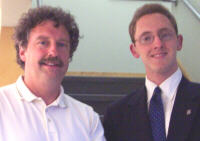
|
In the fall, Jer Brown studied Bessel functions in an ambitious project.
Among other things, Bessel functions can be used to model the motion of a bob on a pendulum whose length changes at a constant rate.
Jer studied the development and
theory of these functions, wrote a C++ program to solve the involved DE's numerically and built a lengthening-pendulum from which to collect data. The data Jer got off this device was amazing.
Jer wisely chose to turn this thesis into a two semester honors thesis through the physics department, and
was indeed awarded honors in physics in the spring.
|

|
In 2002/03 I supervised two thesis students, Sarah Cremer and
Mark Prelli. We're pictured at the end-of-year celebration
party held in the math department.
Sarah wrote a two-semester thesis on the relationship between Q and
P curves and their interactions; this was an extension of Meredith
Odell's work (Meredith appears below).
Mark wrote a one-semester thesis about locating
repelling periodic points of Julia sets, and supplemented his thesis with a computer
program that illustrates graphically two very different ways of finding such points.
(One semester theses were new to the math department this year).
|
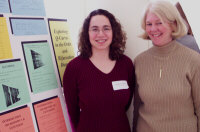
|

|
Sarah and Mark each presented their work at the second annual "Mount David Summit",
an opportunity for all Bates students to share their thesis work with the college
community. Pictured with Sarah is Dean of Faculty Jill Reich.
|
|
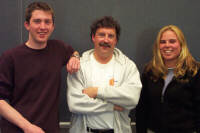
|
I advised two thesis students in 2001/02. Here Sam Hawes
and Meredith Odell
are all smiles after their final thesis presentations in May.
|

|
Here's Meredith just before that presentation. She looks
worried, but it was all just an act. She gave a fine talk,
to a room full of math faculty, other senior math majors, Math Campers, and
a dozen or so of her friends. In her thesis she proved that Q-curves and
P-curves are tangent at C-values for which 0 is on a super attracting periodic
cycle, and that these curves intersect but
are not tangent where 0 is pre-periodic. We hope to publish the results
as a follow up to a paper called "The road to chaos is filled with polynomial
curves" published in 1996 in the American Mathematical Monthly.
|

|
Sam investigated the locations of repelling periodic points for Julia
sets sporting Siegel disks, inparticular doing
a discrete Fourier transform on the
way the distance and angle change as one moves around
one of the disks. The result was terrific.
His investigations were done using
a program he wrote and continually modified as needed to give us insight into
the behavior of these objects.
|
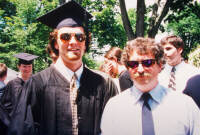
|
Chris Danforth wrote a joint physics/math thesis in 2000/01; I was advisor
for the math part. Chris built a "thermosyphon" to demonstrate the
kind of behavior in a fluid moving as modeled by the Lorenz equations.
The device was very touchy and Chris nearly melted it into a mass of plastic
junk, but it worked! And when he plotted the data collected from the
way the fluid rolled this way, then that way, it was indeed very similar to
the plot of the numeric solutions of the Lorenz equations. The 3D reconstruction plots
were especially revealing. Chris is now a graduate student at the University of
Maryland, working in chaotic dynamical systems.
|

|
Chris was also one of the stars on the Bates tennis team.
He's spent several summers on Squirrel Island, where his family
has a residence, and he teaches tennis. Chris is
rightfully regarded as a tennis
god on the island; when my family and I visited him there in the summer after
his Bates graduation, most of the island's population turned out to watch Chris
in a late afternoon
doubles match with various family members and friends.
Earlier in the day, I got to play tennis with
Chris on those wonderful clay courts, and while ultimately giving me
the expected trouncing, he can never forget that I did win my first game against
him that day!
(Thanks Chris!)
I hope he is able to realize his dream of being a highly regarded
professor at some good school, with his
summers off to play tennis and study on the idyllic, beautiful, Squirrel Island.
|
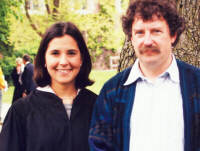
|
In 2000, because of my sabbitacal leave during the spring,
I was unable to serve as Melissa Borr's thesis advisor. I am sorry for
this missed opportunity.
But I still helped her work on it. Missy and I built a device for studying
the frequencies at which nodes form on a square membrane, fixed
along its four boundaries. To see and photograph the nodes, we
poured a small bit of salt on the membrane - a stretched rubber sheet about
4" square - as it was set into motion by a large speaker vibrating
underneath it. The resulting patterns appeared at nearly exactly the
identical frequency ratios as
predicted by the numeric solutions of our mathematical
model of this system. Very Cool! Look for more about this on a future page.
|
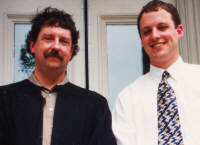
|
Chris Santillo and I enjoyed studying the mysteries of Siegel Disks during
his senior year, 1997-98. We started working in August before
the semester started; the sound of the
pounding-in of Pettingill Hall's first pylons was a constant
background during our discussions in room 207.
Chris and I enjoyed playing various CD's for one another; he introduced
me to the delightful music of Tipsy, and I got him interested in
the amazing guit-steel playing of Junior Brown. In the summer
of 1999, I visited Chris in Massachusetts, and we saw Junior
play a show in Cambridge.
|
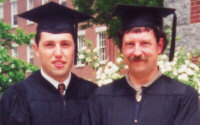
|
Carl Landry '98 didn't write a thesis with me, but he took a number of classes with me and
we became very good friends.
I served as his math major advisor, and in fact,
his advisor for many things about life, money, marriage, happiness.
We enjoyed many discussions about everything. Carl spent many
hours student-teaching
at Lewiston High, and I visited his class one day for an evaluation.
Carl's a natural teacher,
and indeed, has wisely chosen to make a career out of it.
|
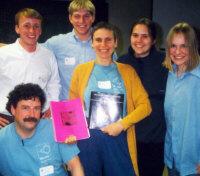
|
In 1997, Brian O'Conner wrote a thesis
based on a study of Feigenbaum's paper
"Quantitative Universality for Nonlinear Transformations".
The picture of us was taken at the 1997 Hudson River Undergraduate
Mathematics Conference, held in April, 1997 at Williams College -
Brian is standing behind me while to his left are Bates students
David Chamberlain, Jamie McDowell and Else Kyyro.
My colleague Bonnie Shulman is in the middle of the photo. All of us
gave talks at this event.
|













